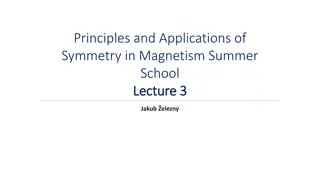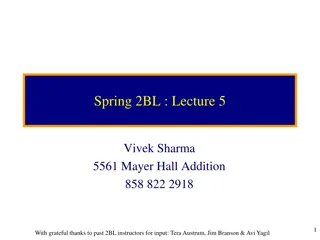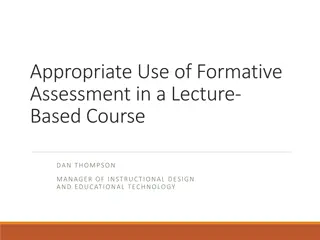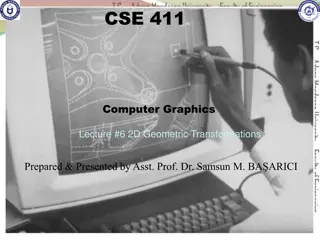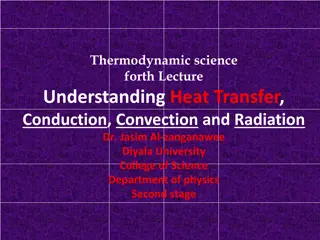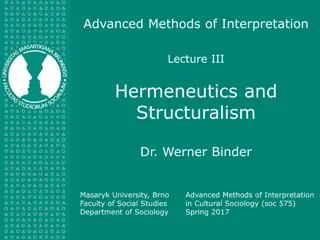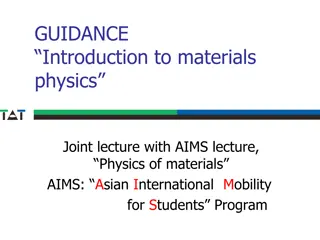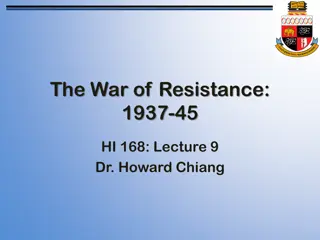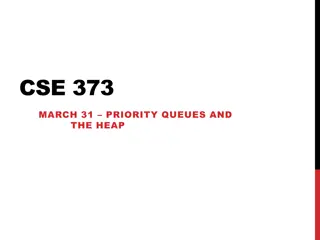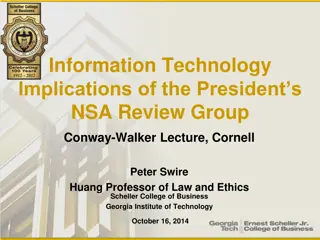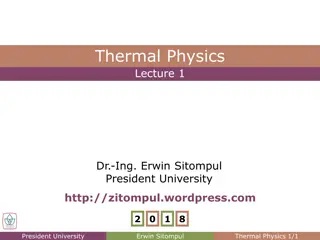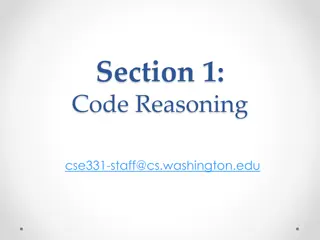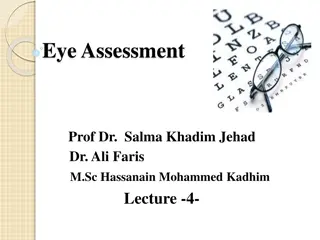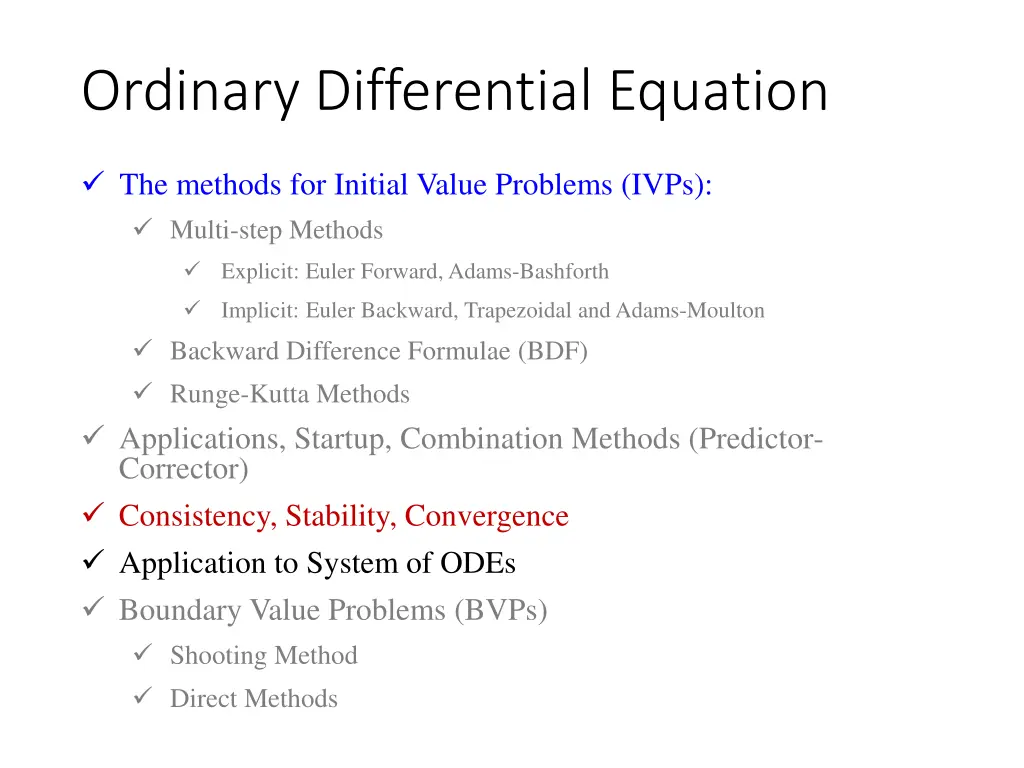
Differential Equation Methods and Stability Analysis
Explore methods for solving ordinary differential equations (ODEs) and dive into stability analysis, consistency, and convergence. Learn about implicit and explicit methods, dealing with non-linear equations, handling numerical oscillations, and the key concepts of stability, consistency, and convergence in numerical methods for initial value problems (IVPs) and boundary value problems (BVPs).
Download Presentation

Please find below an Image/Link to download the presentation.
The content on the website is provided AS IS for your information and personal use only. It may not be sold, licensed, or shared on other websites without obtaining consent from the author. If you encounter any issues during the download, it is possible that the publisher has removed the file from their server.
You are allowed to download the files provided on this website for personal or commercial use, subject to the condition that they are used lawfully. All files are the property of their respective owners.
The content on the website is provided AS IS for your information and personal use only. It may not be sold, licensed, or shared on other websites without obtaining consent from the author.
E N D
Presentation Transcript
Ordinary Differential Equation The methods for Initial Value Problems (IVPs): Multi-step Methods Explicit: Euler Forward, Adams-Bashforth Implicit: Euler Backward, Trapezoidal and Adams-Moulton Backward Difference Formulae (BDF) Runge-Kutta Methods Applications, Startup, Combination Methods (Predictor- Corrector) Consistency, Stability, Convergence Application to System of ODEs Boundary Value Problems (BVPs) Shooting Method Direct Methods
Applications: Summary of Concerns Accuracy of the higher order multi-step and BDF methods are affected if the starting values are used from the lower order methods. How to start these non-self starting algorithms? All implicit methods (multi-step and BDF) may involve solution of non-linear equations (if f contains a non-linear function of the dependent variable y) Is there a way to avoid this solution of non-linear equations? Numerical oscillations (instability) observed in some methods and not in some! Is there a way to predict and therefore, choose correct parameters for algorithm so that the numerical oscillations can be avoided? We will do Convergence Analysis!
ODE: Consistency, Stability, Convergence (Recap; Text Book S6.3.2) A consistent numerical method is said to have an order of accuracy of p, if p is the largest positive integer such that ??? ? ?for 0 < ?, where K and h are constants. For all the methods derived so far, p 1, therefore, consistent! If numerical solutions for an IVP are obtained using a method with two sets of initial conditions ?0,?1,?2, ?? ?0,?1,?2, ?? , the method is stable if there exists a constant K such that the following relation holds as h 0, ??+m ??+m ? max ?0 ?0, ?1 ?1, ?? ?? Zero stability defines stability in asymptotic limit h 0 and ? Consistency and zero stability are necessary conditions for convergence
Numerical Methods for IVPs: Stability For application with h > 0, let us define an amplification factor ( ) ??+1 ?? = ? can be real or complex Condition of stability is satisfied if ? < 1 We need a model problem to assess and compare stability of various methods!
Stability: Model Problem Mathematical Problem: ?? ??= ? ?,? ? ?0 = ?0 ? 0 Using Taylor series expansion in the neighbourhood of fixed initial point (y0, t0) : 2 ?2? ??2 ?? ??= ? ?0,?0 + ? ?0 ?? ?? ?? ?? ? ?0 2 + ? ?0 + ?0,?0 ?0,?0 ?0,?0 ?2? ???? 2 ?2? ??2 ? ?0 2 + ? ?0 ? ?0 + + ?0,?0 ?0,?0 Collecting only the linear terms: ?? ??= ? + ?? + ?? + ?? ??= ?? + ? ?
Stability: Model Problem ?? ??= ?? + ? ? Any approximate solution ? computed using a numerical method satisfies the approximate equation ? ? ??= ? ? + ? ? The error ( ) is defined as: ? = ? ?. We may write: ?? ??= ?? The function of the independent variable ? ? has no influence on the progression of error in the equation. Therefore the model problem for linear stability analysis is: ?? ??= ??; We may evaluate the analytical solution in a discrete grid ?0,?1,?2, ?? with a time step of h: ??= ?0??? ? = ?0??? ? 0 = ?0
Stability: Model Problem For general applicability to all types of functions or problems, we let to be complex: ? = ??+ ??? ??= ?0??? = ?0??? ??? ?? ? The analytical solution grows unbounded, i.e., ? > 1 if ?? > 0 irrespective of the value of ?? ?? We will now derive the stability regions of the numerical methods in the ?? vs. ?? - plane and compare that with the stability region of the analytical solution. ?? Stability region of the analytical solution of the model problem in the ?? vs. ?? - plane
Stability: Multi-Step Methods (explicit) Example Recall: The stability region (in the ?? vs. ?? - plane) of a numerical method is an open set C that contains the collection of those h for which ? < 1. Boundary of the region is often characterized by ? = 1. Since, is a function of h, is complex: ? = ??? ???= 1 ? < 1 < 1 Euler Forward: applying the method to the model problem, ?? ??= ??; ? 0 = ?0 ??= ???0 ??+1= ??+ ? ??= 1 + ?? + ??? ??= ??? 1 + ?? 2+ ?? 2< 1 ? = 1 + ?? + ??? < 1 For real : ??= 0; ??= ? (necessary for stability) 0 < <2 ?
Stability: Multi-Step Methods (explicit) Example Consider our problem: ?? ??= 2? + sin? For stability with Euler forward, h < 1 0 < <2 ?
Stability: Multi-Step Methods (explicit) Example For higher order methods, let s consider 3rd order Adams-Bashforth: Adams-Bashforth (3rd Order): applying the method to model problem: 23 12??? 4 5 12??? 2 ??+1= ??+ 3??? 1+ ?3 ?2 23 12?2 4 ? = ?? + ??? = 3? +5 12 ??+1 ?? = ?;??+1 ?? ?? 2= ?2; ?? 1 ?? 2= ? By recursively applying ?? 2= ?3; In order to plot the region, recall that the boundary of the region is characterized by ? = 1 or ? = ??? cos3? cos2? + ? sin3? sin2? 23 12cos2? 4 ?? + ??? = 3cos? +5 23 12sin2? 4 12+ ? 3sin? One can now easily compute ?? and ?? for ? 0,2? Let s compare the stability regions of all the explicit multi-step methods!
Stability: Multi-Step Methods (explicit) Example All explicit methods are conditionally stable. Consider our problem: ?? ??= 2? + sin? For stability with Adams-Bashforth (4th Order), h < 0.3/2 = 0.15
Stability: Multi-Step (Implicit) Euler Backward: applying the method to the model problem, ??+1 ?? 1 1 1 ??+1= ??+ ???+1 = ? = 1 ? = 1 ?? ??? = ?? 1 ?? ???? ? = tan 1 1 ?? 2+ ?? 2; ? = 1 ? 1 ?? 2+ ?? 2> 1 ? < 1 < 1 Euler Backward method is stable everywhere outside the circle! Homework: Stability region of the Trapezoidal Method!
Stability: Multi-Step Methods (implicit) Example For higher order methods, let s consider 3rd order Adams-Moulton: Adams-Moulton (3rd Order): applying the method to the model problem, 5 12???+1+2 1 12??? 1 ??+1= ??+ 3??? ?2 ? 3? 1 cos2? cos? + ? sin2? sin? 12cos2? +2 ?? + ??? = = 12?2+2 5 5 3cos? 1 12sin2? +2 5 12+ ? 3sin? 12 One can now easily compute ?? and ?? for ? 0,2? Let s compare the stability regions of all the implicit multi-step methods!
Stability: Multi-Step Methods (implicit) Example Euler backward method is unconditionally stable! (It is stable everywhere, where the analytical problem is also stable) Trapezoidal: find as homework! Adams-Moulton 3rd and 4th order methods are conditionally stable! Pay attention to the stability for purely imaginary !
Stability: BDF Methods Example 1storder BDF is the Euler Backward. For higher order methods, let s consider 3rd order BDF: BDF (3rd Order): applying the method to the model problem, 11 6??+1 3??+3 11 6 3 2?? 1 1 3 2?2 3?? 2= ? ??+1 1 ? = ?? + ??? = ?+ 3?3 ??+1 ?? = ?;??+1 ?? ?? 2= ?2; ?? 1 ?? 2= ? By recursively applying ?? 2= ?3; 11 6 3cos? +3 2cos2? 1 3cos3? ? 3sin? 3 2sin2? +1 = 3sin3? One can now easily compute ?? and ?? for ? 0,2? Let s compare the stability regions of all the BDF methods!
Stability: BDF Methods Example For all the BDFs: Stability Region is outside the enclosed region! For real , all the BDFs are unconditionally stable! One can use any h without having to worry about the stability! Useful for stiff equations!
Stability: Runge-Kutta Methods Example Let s consider 2nd order Runge-Kutta method for illustration: R-K Method (2nd Order): applying the method to the model problem, ??+1= ??+1 2?1, ?0= ? ??,??, ?1= ? ??+ ?0,??+ ??+1= ??+1 2 ? ??+ ??? 1 + ? +1 ?? One needs to find the roots of the polynomial to compute ?? and ?? for ? 0,2? 2?0+1 2 ???+1 2? 2=??+1 = ? = ???= cos? + ?sin?, ? 0, 2? For 2nd order R-K, the roots of the quadratic polynomial can be computed analytically! For the 3rd and 4th order R-K, the roots have to be computed numerically. Use complex version of Newton-Raphson. (Hint: roots are complex conjugates) Let s compare the stability regions of 2nd and 4th order R-K methods!
Stability: Runge-Kutta Methods Example 4th order R-K has very good stability properties ( h up to 2.78 on the real part and 2.83 on the imaginary part) The method is also stable for purely imaginary h Homework: For our problem, check the stability limits of the R-K methods!
Phase Error Let s consider a problem with purely imaginary : ?? ??= ???, Analytical Solution: ??= ?0??? ? = ?0cos? ? + ?sin? ? ? 0 = ?0 Let s apply Euler Forward: ??+1= ??1 + ?? Solve with ? = 1; ?0= 1 and = ?/10 For periodic functions, there are phase error associated with the numerical solution. Can we quantify them?
Phase Error Let s consider a problem with purely imaginary : ?? ??= ???, Analytical Solution: ??= ?0??? ?= ?0cos? ? + ?sin? ? The amplification factor is: ?????=??+1 ?? ?0??? ? ? 0 = ?0 =?0??? ?+1 = ??? Amplitude: |?????| = cos2? + sin2? = 1 sin? cos? Phase: ?????= tan 1 = ? We will compare the amplitude and phase of the amplification factor of the numerical methods!
Phase Error Euler Forward: ??+1= ??1 + ?? ? = 1 + ?? Amplitude: |?| = 1 + ? 2> |?????| = 1 (No surprise here! We already know that Euler Forward method is not stable for purely imaginary ) Im ? Re ? Phase: ? = tan 1 = tan 1? ? 5 5! ? 3 3! ? 7 7! ? 9 9! tan 1? = ? + + Phase Error (PE) for Euler Forward is given by, ? 3 3! ? 5 5! ? 7 7! ? 9 9! ?? = ????? ? = ? tan 1? = +
Phase Error Euler Backward: 1 1 ?? , ? = ? 3 6 1 1 + ? 2, ? = tan 1? ,?? = ? = Trapezoidal: 1 + ?1 1 ?1 2? ? 3 12 , |?| = 1, ? = 2tan 1? ? = ,?? = 2 2? Runge-Kutta (2nd Order): ? 2 2 ? 4 4 ? , ? = tan 1 ? = 1 + ?? , ? = 1 + 1 ? 2 2 ? 3 6 ?? = Positive PE: phase lag Negative PE: phase lead
Arbitrary f How to choose time step h for arbitrary non- linear f: Expand fin Taylor s series around the initial condition, retain the first two terms (linear terms) to obtain the equivalent model problem set = coefficient of y compute h from the stability diagram! To account for the non-linearity, stay well below the stability limit!


